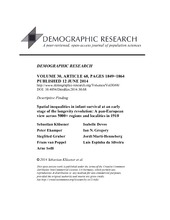| dc.contributor.author | Klüsener, Sebastian | eng |
| dc.contributor.author | Devos, Isabelle | eng |
| dc.contributor.author | Ekamper, Peter | eng |
| dc.contributor.author | Gregory, Ian | eng |
| dc.contributor.author | Gruber, Siegfried | eng |
| dc.contributor.author | Marti-Henneberg, Jordi | eng |
| dc.contributor.author | van Poppel, Frans | eng |
| dc.contributor.author | da Silveira, Luis | eng |
| dc.contributor.author | Solli, Arne | eng |
| dc.date.accessioned | 2015-09-17T13:11:11Z | |
| dc.date.available | 2015-09-17T13:11:11Z | |
| dc.date.issued | 2014-06-12 | |
| dc.Published | Demographic Research 2014, 30(1):1849-1864 | eng |
| dc.identifier.issn | 1435-9871 | |
| dc.identifier.uri | https://hdl.handle.net/1956/10466 | |
| dc.description.abstract | Background: Spatial inequalities in human development are of great concern to international organisations and national governments. Demographic indicators like the infant mortality rate are important measures for determining these inequalities. Using demographic indicators over long time periods at relatively high levels of geographical detail, we can examine the long-term continuities and changes in spatial inequalities. Objective: This paper presents the initial outcomes of a larger project that aims to analyse spatial variation in infant survival across Europe over the last 100 years. In this paper, we focus on spatial disparities in infant survival in 1910. At that time, the longevity revolution was still at an early stage. We look at general spatial variation patterns within and across countries, and discuss some of the challenges related to the comparativeness of the data. Methods: We link official infant mortality data from more than 5,000 European regions and localities for the period around 1910 to a European historical GIS of administrative boundaries. The data are analysed using descriptive spatial analysis techniques. Results: In 1910, a number of countries in northern and western Europe led the longevity revolution in Europe, with the area of low infant mortality also extending into the northwestern parts of the German Empire. Other areas with low infant mortality levels included the Belgian region of Wallonia, most parts of Switzerland, as well as central and south-western France. In eastern and southern Europe, we find significant variation within and across countries, which might stem in part from data quality problems. | en_US |
| dc.language.iso | eng | eng |
| dc.publisher | Max Planck Institute for Demographic Research | eng |
| dc.rights | Attribution CC BY-NC | eng |
| dc.rights.uri | http://creativecommons.org/licenses/by-nc/2.0/de/ | eng |
| dc.title | Spatial inequalities in infant survival at an early stage of the longevity revolution: A pan-European view across 5000+ regions and localities in 1910 | eng |
| dc.type | Peer reviewed | |
| dc.type | Journal article | |
| dc.date.updated | 2015-07-28T11:35:42Z | |
| dc.description.version | publishedVersion | |
| dc.rights.holder | Copyright 2014 Sebastian Klüsener et al. | eng |
| dc.source.articlenumber | 68 | |
| dc.identifier.doi | https://doi.org/10.4054/demres.2014.30.68 | |
| dc.identifier.cristin | 1155990 | |
| dc.source.journal | Demographic Research | |
| dc.source.40 | 30 | |
| dc.source.pagenumber | 1849-1864 | |
| dc.subject.nsi | VDP::Samfunnsvitenskap: 200::Demografi: 300 | |
| dc.subject.nsi | VDP::Social sciences: 200::Demography: 300 | |

